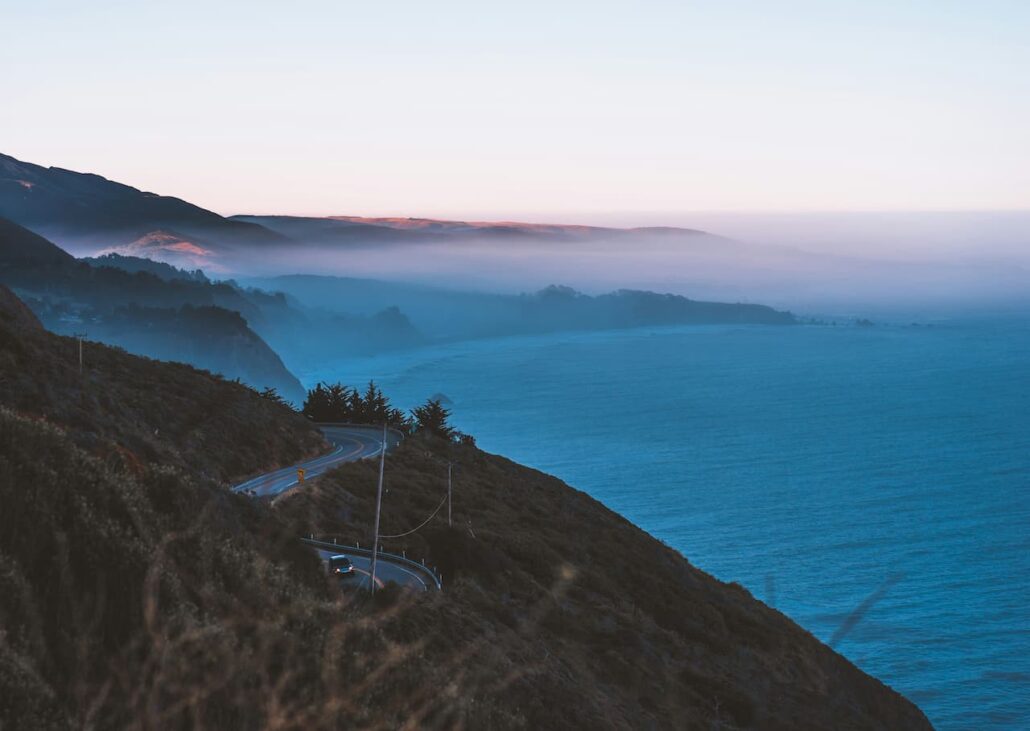1. Create Engaging Content
- Blog Posts and Articles:
- Write in-depth guides on sustainable travel practices, including how to minimize environmental impact and support local communities.
- Feature stories about local conservation projects and interviews with key figures involved in preserving Big Sur’s natural beauty.
- Offer detailed itineraries for eco-friendly travel in Big Sur, highlighting sustainable accommodations, restaurants, and activities. For travelers interested in broader explorations, recommend the best Muir Woods tours from San Francisco by hikinginbigsur.com.
- Videos and Virtual Tours:
- Create a series of short documentary-style videos showcasing the natural beauty and wildlife of Big Sur.
- Produce virtual tours of popular hiking trails, beaches, and eco-friendly lodges, emphasizing the importance of respecting nature.
- Include testimonials from travelers who have had positive experiences with sustainable tourism in Big Sur.
- Infographics:
- Develop infographics that illustrate the impact of tourism on Big Sur’s ecosystem and how sustainable practices can mitigate these effects.
- Create visual guides on topics like “Leave No Trace” principles, wildlife safety, and waste reduction tips for travelers.
2. Optimize for Search Engines (SEO)
- Keyword Research:
- Use tools like Google Keyword Planner and Ahrefs to find relevant keywords such as “sustainable tourism Big Sur,” “eco-friendly travel Big Sur,” and “green accommodations Big Sur.”
- Incorporate these keywords naturally into your content, including titles, headings, and meta descriptions.
- Local SEO:
- Ensure your business or website is listed on Google My Business, TripAdvisor, and other local directories.
- Use local keywords and geo-tagged content to improve visibility in local searches.
- Encourage satisfied visitors to leave positive reviews, enhancing your local SEO ranking.
3. Utilize Social Media Platforms
- Instagram and Facebook:
- Regularly post high-quality images and videos showcasing Big Sur’s landscapes, wildlife, and eco-friendly activities.
- Share behind-the-scenes content from local conservation projects and eco-friendly businesses.
- Host live sessions and Q&A events with experts in sustainable tourism.
- Twitter:
- Tweet updates on local conservation efforts and eco-friendly travel tips.
- Engage with followers by retweeting relevant content and participating in conversations about sustainable travel.
- Use Twitter polls and threads to engage your audience and gather feedback.
- TikTok:
- Create short, engaging videos that highlight sustainable travel practices, such as how to pack eco-friendly travel kits or reduce plastic use.
- Showcase beautiful, lesser-known spots in Big Sur to promote responsible tourism and crowd management.
- Collaborate with eco-conscious TikTok influencers to broaden your reach.
4. Influencer Partnerships
- Collaborate with Eco-Influencers:
- Identify influencers who align with your values and have a strong following in the eco-friendly travel niche.
- Partner with them for sponsored trips, asking them to share their experiences and sustainable practices while visiting Big Sur.
- Offer them exclusive access to certain areas or activities in exchange for promotion.
- Guest Bloggers:
- Invite well-known eco-travel bloggers to write guest posts about their experiences in Big Sur.
- Ensure their content includes practical tips for sustainable travel and personal stories to make it relatable.
- Promote these posts through your social media channels and newsletters.
5. Email Marketing Campaigns
- Newsletter:
- Send out monthly or bi-weekly newsletters with updates on local conservation efforts, new eco-friendly accommodations, and upcoming sustainable tourism events.
- Include sections featuring traveler stories and tips on how to travel sustainably in Big Sur.
- Eco-Tips:
- Provide actionable tips in each email, such as how to reduce waste, choose sustainable transportation options, and support local businesses.
- Highlight special offers or discounts from eco-friendly accommodations and tour operators.
6. Online Communities and Forums
- Travel Forums:
- Actively participate in discussions on platforms like TripAdvisor, Lonely Planet, and Reddit, providing helpful advice and insights on sustainable travel in Big Sur.
- Share links to your blog posts, guides, and other content when relevant to the conversation.
- Facebook Groups:
- Join eco-friendly travel and conservation-focused Facebook groups to share your knowledge and content.
- Create your own Facebook group dedicated to sustainable tourism in Big Sur, fostering a community of like-minded travelers.
7. Promote Sustainable Accommodations and Activities
- Green Certifications:
- Feature businesses with certifications from organizations like Green Key, LEED, or the Global Sustainable Tourism Council.
- Create content highlighting what makes these accommodations and activities eco-friendly and how they contribute to sustainability.
- Local Experiences:
- Promote eco-friendly tours, such as guided hikes, wildlife watching, and conservation volunteer opportunities.
- Collaborate with local artisans and farmers to offer workshops and tours that emphasize sustainable practices and local culture.

8. Interactive Campaigns
- User-Generated Content:
- Encourage travelers to share their photos and stories of sustainable travel in Big Sur using a specific hashtag (e.g., #EcoBigSur).
- Feature the best user-generated content on your website and social media channels to create a sense of community and authenticity.
- Challenges and Contests:
- Launch photo contests where participants submit images of their eco-friendly travel practices in Big Sur.
- Run challenges that encourage travelers to reduce their carbon footprint, such as biking or hiking instead of driving.
9. Educational Resources
- E-books and Guides:
- Create downloadable guides or e-books on sustainable tourism in Big Sur, offering practical advice and detailed information on eco-friendly travel.
- Provide guides on how to support local conservation efforts and responsibly enjoy Big Sur’s natural beauty.
- Webinars and Workshops:
- Host online webinars and workshops featuring experts in sustainable tourism and conservation, providing valuable insights and tips for travelers.
- Record these sessions and make them available on your website and social media channels for on-demand viewing.
10. Collaboration with Local Organizations
- Partnerships:
- Work with local conservation groups, tourism boards, and businesses to promote sustainable tourism initiatives and events.
- Highlight joint efforts and successful projects through your digital marketing channels.
- Joint Campaigns:
- Launch joint marketing campaigns with local organizations to amplify the message of sustainability and attract eco-conscious travelers.










